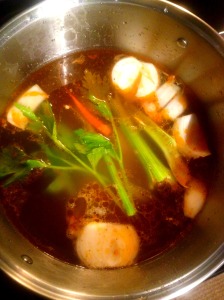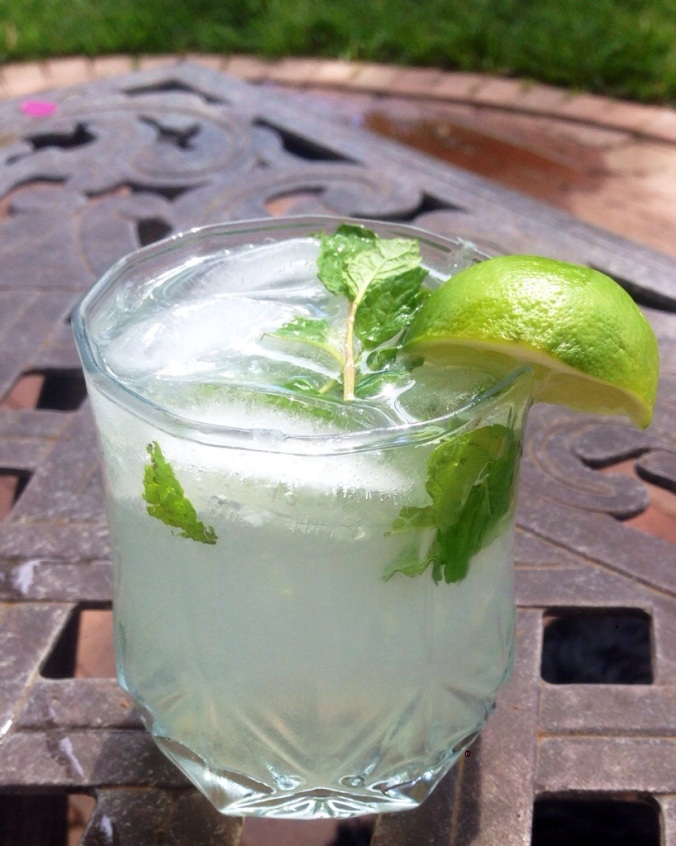It’s shockingly GOOD, people.
WARNING: May cure all ailments known to man.
Guts that leak, and how to fix ’em with bone broth!
Making broth out of leftover bones is an age-old tradition that thankfully has made a big comeback in the last 15-20 years (props to you, Sally Fallon). I first learned of it when reading Nourishing Traditions several years ago, and I was SO afraid of making it at first, but once I finally did…there was no going back. The broth from a box would never enter my pantry again, and a new batch was made every weekend from there on out.
An old South American proverb goes as far to say that “good broth will resurrect the dead.” Well I don’t know about that, but it certainly has given my gut a new life. You see, broth is extremely rich in gelatin and has a wide array of amino acids. So not only is it a wonderful aid for detoxification, but it can literally help to rebuild the lining of your gut. Dr. Natasha Campbell-McBride, the author of the GAPS diet, is a major proponent of using this magical golden elixir in her protocols for gut healing, and it seems like bone broth is even starting to go mainstream. Well why would we need to fix our guts in the first place, you ask?
You see, there was a debate for several years in the medical realm as to whether “leaky gut,” or more formally, “intestinal hyperpermeability,” existed. After much research, it is now widely accepted and although usually associated with Celiac disease and Crohn’s disease, there are actually many more people that suffer with the syndrome.
But WHY does this happen!?
Well, there are some theories and having experienced leaky gut myself I can certainly attest to them.
1. Overuse of antibiotics. According to Dr. Natasha, “antibiotics have a devastating effect on beneficial bacteria in the human body, not only in the gut but in other organs and tissues. [It] changes bacteria, viruses, and fungi from benign to pathogenic, giving them an ability to invade tissues and cause disease. Antibiotics make bacteria resistant to antibiotics, so the industry has to work on more and more powerful new antibiotics to attack these new changed bacteria. A good example is tuberculosis, where wide use of antibiotics has created new varieties of these Mycobacterium Tuberculosis resistant to all existing antibiotics. They also have a direct damaging effect on the immune system, making us more vulnerable to infections, which leads to a vicious cycle of more antibiotics and more infections.” (emphasis is mine)
So not only can antibiotics completely change your gut flora (the bacterial environment), but it can cause pathogens to become SO harmful that they invade the tissues within your body. In her book, Gut and Psychology Syndrome, or “GAPS” for short, Dr. Campbell-McBride goes through each class of antibiotics and gives an overview of what each one can do. For example, penicillin “allow[s] bacteria normally found only in the bowel to move up to the intestines, which predisposes the person to development of IBS (Irritable Bowel Syndrome) and other digestive disorders.”
…and that’s just one group of antibiotics.
Now, I’m not saying to NEVER EVER take a round of antibiotics. Modern medicine is here for a reason and many lives are saved every day because of it. However, throwing antibiotics at every sniffle, every earache (which is usually viral anyway) and every patient that walks into a doctor’s office–whether they need them or not– is definitely (in my opinion) causing more problems than they can possibly fix.
2. Diet. Diet. DIET.
Well gluten has certainly become a buzzword, hasn’t it? Gluten is a protein composite that is highly indigestible. It’s added to sauces, dressings, and breads to make them thicker and more appealing. My brother Blake realized he was gluten-intolerant back in ’99 and I always loved seeing
waitresses’ faces (see pic) when he would ask them, “does this dish have gluten in it?”
Priceless.
But now it seems that I cannot go a day without someone asking me about gluten, seeing gluten in the morning news, or even watching it in a skit on late night television.
The fact of the matter is, there are foods that are harmful to your gut, and gluten is certainly one of them. . “Leaky gut” is exactly what it sounds like: the walls of your gut allow particles of food like protein chains or fatty acids to leak out. This means that even if you don’t have Celiac, the tight junctions that make up the lining of your gut can start to separate, loosen, and let things OUT that are meant to stay IN. People with Celiac have a very large, awful, exaggerated version of this. Need a visual? Hold hands with yourself (the married/dirty way, with fingers interlocked;)). This represents the tight junctions that make up the lining of your gut. Now start to pull your arms apart, keeping fingers interlocked. You’ll start to see the gaps between your fingers <–this is where the food particles get out. Very scientific, no?
How gluten separates the doors of your gut wall
Since the wheat of today is not the wheat of yesteryear, there are some indigestible portions of it. Because the gut has trouble digesting gluten, it will release the protein zonulin, which loosens those tight junctions in order to let the food out. Now, your body tends to see these escaped food particles as foreign invaders if you are predisposed to an autoimmune disease–any autoimmune disease, not just Celiac– so it will begin to attack those food particles and inflammation can set in. This is why some people will complain of joint pain or headaches when they’ve been exposed, or “gluten-ed.”
Fix that gut.

It’s not considered a selfie if you have bone broth in-hand and a napping Kelpie in the background 😉
So now to the recipe for magical bone broth to heal your tummy nicely. You see, Christine (a.k.a. “Steen”) and I want to bring you INFO first so that a) you can teach others b) you can implement these strategies knowing WHY you’re doing them (so, not just to be “trendy”) and c) so that in the off-chance you are bombarded by Jimmy Kimmel’s crew, you will actually know what the heck you’re talking about. Don’t be that person on Jimmy Kimmel that has no idea what gluten is! You have no excuse now!
Between ridding your diet of processed foods, adding probiotics like BioKult & Prescript-Assist, consuming properly-prepared sauerkraut, kimchi, raw kefir, and having some bone broth on a regular basis, you will give your gut the best chance to heal itself and function properly.
I like to roast a whole chicken first, so there are two recipes below. One is strictly for broth and the other is to make a roasted chicken and broth out of the leftovers. I usually leave some of the meat on the bones after I’ve used the rest for chicken salad or tacos. Hope you enjoy, and remember: FOLLOW YOUR GUT :)!
Chicken Bone Broth: A golden, magical gut healer
Makes 1 stockpot + a bonus meal Prep time: 5 minutes Cooking time: 1.5 hours to roast, 24 hours to simmer bones
Ingredients for broth:
- 1 whole chicken (for roasting directions, see below), or you can just use the bony parts of a chicken (neck, feet <–very gelatinous!, wings, gizzards, etc.) Farm-raised, free-range chicken is best to get a broth that will gel
- 2 Tbsp. of an acidic medium. You can use raw apple cider vinegar or lemon juice. This helps to bring extra calcium out of the bones and into your broth
- About 2 quarts of fresh, purified water (the cleaner the source, the better the broth)
- 2-3 carrots, thoroughly washed and/or peeled and roughly chopped
- 2-3 stalks of celery, roughly chopped
- 1 yellow onion, roughly chopped
- 1 bunch of fresh parsley
Ingredients for roasted chicken (that can later be turned into broth!)
 1 whole chicken (farm-raised, free-range chicken is best to get a broth that will gel)
1 whole chicken (farm-raised, free-range chicken is best to get a broth that will gel)- 1-2 Tbsp. of your favorite butter, melted (I recommend either raw butter from grass-fed cows or Kerrygold Irish butter)
- 1/2 tsp sea salt (I prefer Pink Himalayan or Redmond’s Real Salt)
- 1/2 tsp black pepper
- 1/3-1/2 tsp smoked paprika
- 1/3-1/2 tsp Simply Organic All-Purpose seasoning
- 2-3 cloves of fresh garlic, chopped
Let’s be real here. All of those seasoning measurements are approximate–just eyeball it, because seasoned, roasted chicken skin is absolutely delicious.
Directions:
- If you decide to roast your chicken first: place chicken in a baking pan and season it with all of the seasonings. Brush melted butter on the outside of the chicken, thoroughly covering it. Season once again. If you’re going to roast vegetables alongside the chicken, place those in the pan as well. Cook at 350*F for 1.5 hours.
- Once the chicken is consumed & de-boned (or if you decide to forego the roasting and want to use the whole chicken in the stockpot): Place the chicken, whether whole or leftovers, in the stockpot and add the water, vinegar, and all the vegetables except for parsley. If using a whole chicken, cut the wings and neck into several pieces so that everything fits into the pot.
- Bring the water to a boil, then turn it down. You’ll notice some scum float to the top–you’ll want to scoop that off with a ladle or it can give the broth a bitter flavor.
- Let the broth simmer in the pot with lid on for 12-24 hours (longer is better). During the last 10-15 minutes of cooking, toss in the fresh parsley (this will add a lot of minerals and a wonderful taste). Once it is finished cooking and has had a chance to cool,you can strain the liquid into mason jars and refrigerate it for about a week. If you used a whole chicken, you can de-bone it at this point and use the meat.
 Helpful tips: Chicken feet make a broth REALLY gel, so if you can get your hands on some then I highly suggest you add them to your batch. Also, if you want to use a little bit of broth here and there in recipes, consider freezing it in silicone ice cube trays so you can pop some out without having to defrost an entire container.
Helpful tips: Chicken feet make a broth REALLY gel, so if you can get your hands on some then I highly suggest you add them to your batch. Also, if you want to use a little bit of broth here and there in recipes, consider freezing it in silicone ice cube trays so you can pop some out without having to defrost an entire container.
I hope you enjoy these recipes! Feel free to ask questions or leave comments in the comments section or by a contact form. If you’re enjoying these posts and want to be alerted to new ones, subscribe!
‘Til next time,
Citations: McBride, N. (2010). What Can Damage Gut Flora?. Gut and psychology syndrome: natural treatment for autism, dyspraxia, A.D.D., dyslexia, A.D.H.D., depression, schizophrenia(Rev. and expanded ed., ). Cambridge, U.K.: Medinform Pub.]
View our disclaimer here



